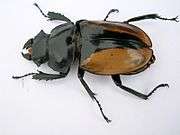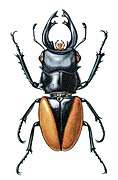Odontolabis cuvera
Odontolabis cuvera, the Golden Stag Beetle, is a beetle of the Family Lucanidae, stag beetles.
| Odontolabis cuvera | |
|---|---|
| Odontolabis cuvera, male and female. Museum specimen | |
| Scientific classification | |
| Kingdom: | |
| Phylum: | |
| Class: | |
| Order: | |
| Family: | |
| Genus: | |
| Species: | O. cuvera |
| Binomial name | |
| Odontolabis cuvera Hope, 1842 | |
Etymology
The Latin species name Cuvera comes from a mythical king of riches (Kubera or "Kuvera") who lived in the Himalayas.[1]
List of subspecies
- Odontolabis cuvera alticola Möllenkamp, 1902
- Odontolabis cuvera boulouxi Lacroix, 1984
- Odontolabis cuvera cuvera Hope, 1842 (Bhutan, India, Nepal)
- Odontolabis cuvera fallaciosa Boileau, 1901 (China, Laos, Thailand, Viet Nam)
- Odontolabis cuvera gestroi Boileau, 1902 (India, Myanmar)
- Odontolabis cuvera lunulata Lacroix, 1984
- Odontolabis cuvera mandibularis Möllenkamp, 1909
- Odontolabis cuvera sinensis Westwood, 1848 (China)
Description
Odontolabis cuvera can reach a length (mandibles included) of about 43–90 millimetres (1.7–3.5 in) in male, of about 41–51 millimetres (1.6–2.0 in) in females.[3] Moreover, males have a conspicuosly elongated and large pair of mandibles. The basic color of the body is black. Elytra have broad orange margins on the outer edge. The female closely resembles the male in coloration but it lacks long mandibles.[1]
The remarkably disparity between male and females (sexual dimorphism) evolved through sexual selection for securing mating females.[4] The males have also three morphological forms with variations in the size of their mandibles. These three alternative phenotypes (male trimorphism) in the types of male weapons are considered conditional reproductive strategies.[5][6]
In the subspecies Odontolabis cuvera sinensis elytra are almost completely black, with a small orange border. These beetles can reach a length of about 80 millimetres (3.1 in).[7]
Life cycle
The females lay their eggs into leaf litter substrate and rotten wood. Larvae build their cave system and stay inside it, feeding for several years on rotting wood.[8]
Distribution
This beetle is native to southeast Asia and it is present in Bhutan, China, India, Laos, Myanmar, Nepal, Thailand, Viet Nam.[1]
Gallery
 Odontolabis cuvera from Talakaveri, Coorg
Odontolabis cuvera from Talakaveri, Coorg- Odontolabis cuvera sinensis. A 65 mm long male.
 Odontolabis cuvera. Adult from the Texas A&M University Insect Collection in College Station
Odontolabis cuvera. Adult from the Texas A&M University Insect Collection in College Station Odontolabis cuvera. Illustration from the Journal of the Bombay Natural History Society
Odontolabis cuvera. Illustration from the Journal of the Bombay Natural History Society
Monograph
- Lacroix, J.-P., 1984 - The Beetles of the World, volume 4, Odontolabini I (Lucanidae) - Genera Chalcodes, Odontolabis, Heterochtes. 1984, 175 pg.
References
- E. A. D'Abreu The beetles of the Himalayas Calcutta and Simla Thacker, Spink and Co (1915)
- Biolib
- Beetle Space
- K Kawano Developmental Stability and Adaptive Variability of Male Genitalia in Sexually Dimorphic Beetles The American Naturalist - The University of Chicago
- J. Mark Rowland and Douglas J. Emlen Two Thresholds, Three Male Forms Result in Facultative Male Trimorphism in Beetles Science 6 February 2009: Vol. 323 no. 5915 pp. 773-776
- Frederick William Hope (1842) On some rare and beautiful coleopterous insects from Silhet, the major part belonging to the collection of Frederic Parry, Esq., of Cheltenham Annals and Magazine of Natural History, The Linnaean Society, Vol. 9, pg. 247-248
- Insect Life Forms
- Beetles breeding